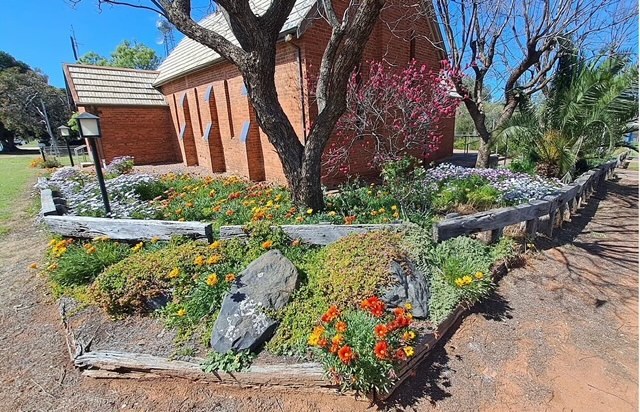Condobolin Anglican Church Makeover
Lucy Kirk
26 November 2022, 2:40 AM
 Photo credit to Sarah Ostenfeld
Photo credit to Sarah OstenfeldA much needed makeover has begun on the grounds around the heritage-listed All Saints Anglican Parish Church on McDonnell Street in Condobolin.
While, for locals passing by, the current state of the grounds is a sad sight Church Warden Sue Thomas promises it is an essential makeover, and that its beauty will be restored in no time.
"I agree it is a horrible process but it is essential. It will be lovely again in time," she said.
A local council grant to remove all landscaping, garden beds and trees that are affecting the stability of the brickwork and foundations is hoped to eliminate the impact of rising damp to the building.
The rising damp is currently affecting the foundations, windows’ alignments and internal wall coatings brought on by problematic downpipes, landscaping and the concrete perimeter ‘collar’ around the church.
The project will entail remedial works to the foundations, replacement of all guttering, redirecting storm water flow away from the building's foundations, erecting disabled access and laying gravel paths.

"Added to this down the track will be the reinstatement of a suitable garden and a heritage fence," said Sue.
"It's a terrible and expensive process, but absolutely essential."
The Church's historical significance to the community of Condobolin is notable, and a huge contributing factor to why the upgrades have been dubbed necessary.
Established in 1880, the church was added to the New South Wales State Heritage Register on 2 May 2008 and is the only state-listed heritage building in the Lachlan Shire.
It was added because of its aesthetic, rarity and representative values in exemplifying the qualities of a small and relatively intact Gothic-styled church attributed to colonial architect Edmund Blacket.
Edmund Blackett was the official "Colonial Architect to New South Wales," known for his designs for the University of Sydney, St. Andrew's Cathedral, Sydney and St. Saviour's Cathedral, Goulburn.
Blacket is also known to have had direct personal ties with the Condobolin district.
The church also contains a rare intact set of windows by Lyon, Cottier & Co. that were installed when the church was built, and significant elaborately carved furniture. A full set of Lyon, Cottier & Co stained glass windows of the quality of the ones in the Condobolin church are rare today.
The builder of the Church was Mr Brinsmead and it was constructed from local bricks; reputedly the first brick building in Condobolin produced by Condobolin brickworks, using local clay, giving a characteristic red colouring to the church (the same local bricks were used for the Condobolin Catholic Church in the 1920s).
The roof was of ironbark shingles (which were later replaced by aluminium tiles) and the furniture was made from local timbers. The original pews still remain in the Church.
The Church is an aesthetically pleasing building, held in high esteem by the local and broader community. The congregation are hopeful that through detailed research, they will be able to reveal further information about its architectural design and heritage value to the community.
The upgrade works are expected to take a couple of years to complete in full.
